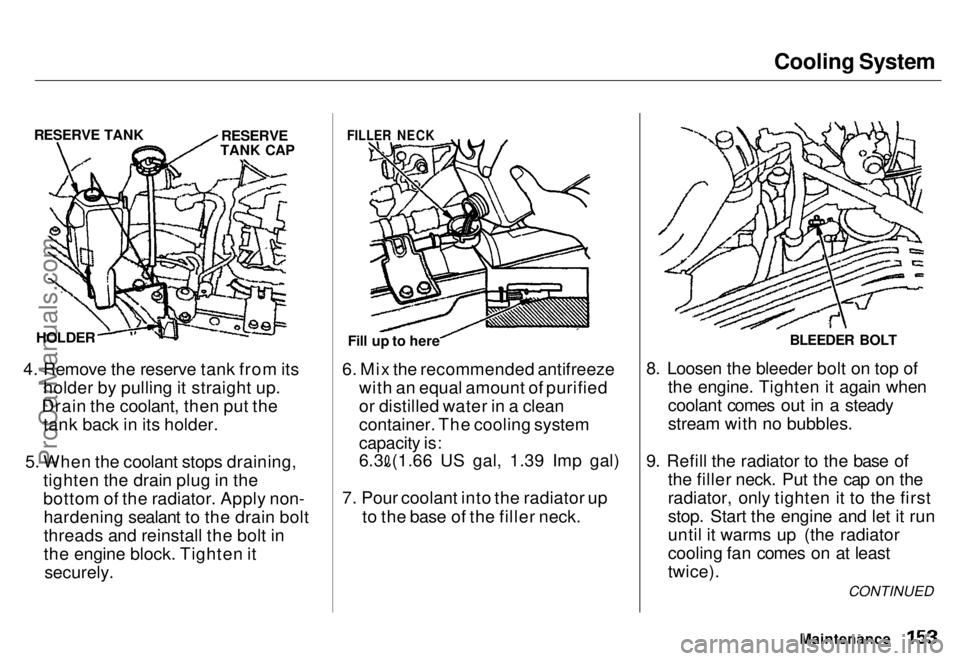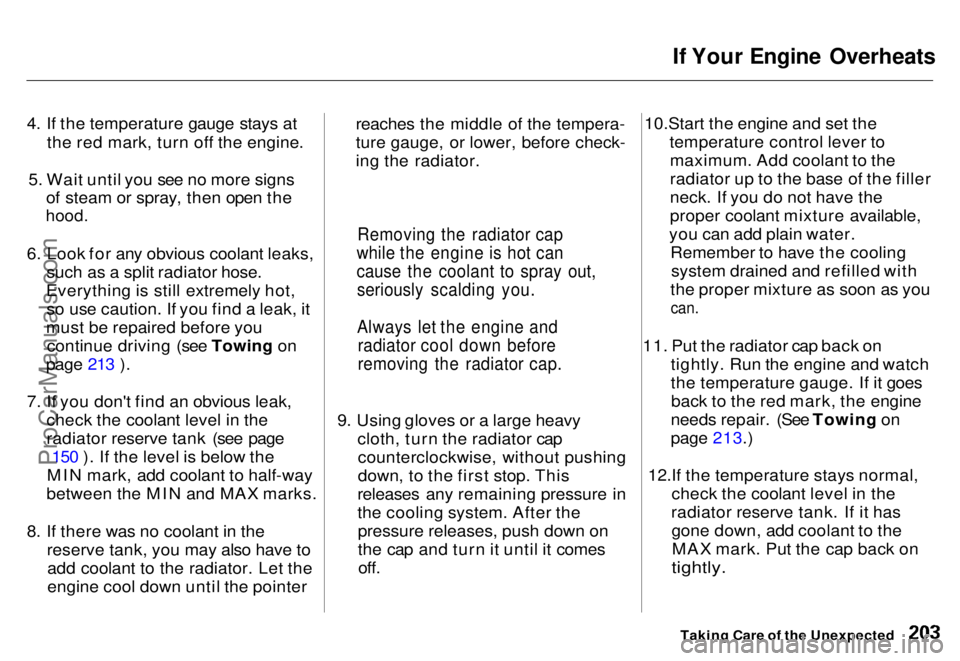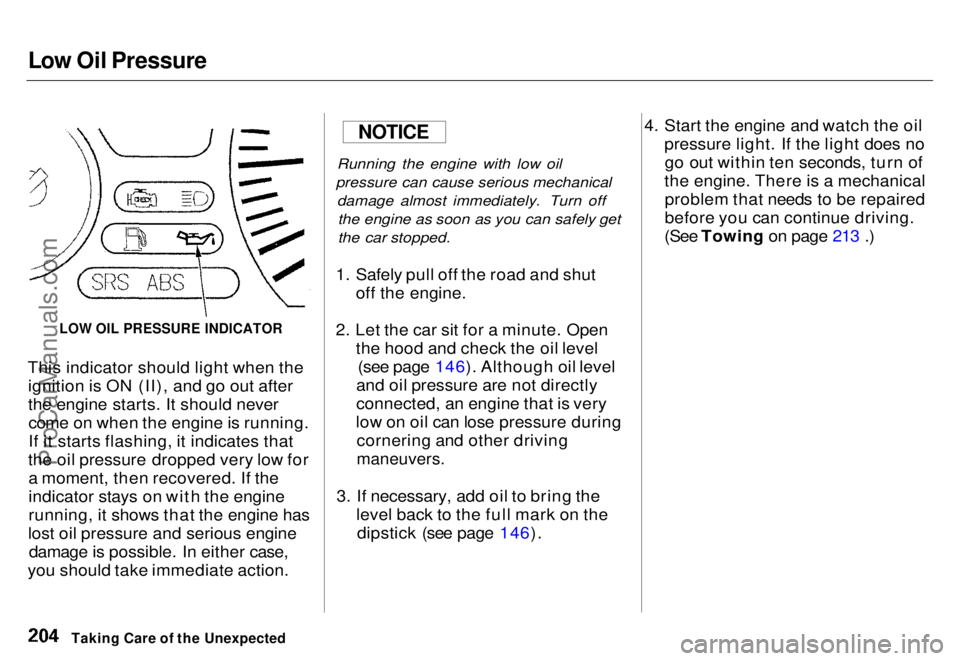Page 152 of 240

Cooling System
RESERVE TANK
RESERVE
TANK CAP
HOLDER
4. Remove the reserve tank from its holder by pulling it straight up.
Drain the coolant, then put the tank back in its holder.
5. When the coolant stops draining, tighten the drain plug in the
bottom of the radiator. Apply non-hardening sealant to the drain bolt
threads and reinstall the bolt in
the engine block. Tighten it securely.
FILLER NECK
Fill up to here
6. Mix the recommended antifreeze with an equal amount of purified
or distilled water in a clean
container. The cooling system
capacity is:6.3 (1.66 US gal, 1.39 Imp gal)
7. Pour coolant into the radiator up
to the base of the filler neck. BLEEDER BOLT
8. Loosen the bleeder bolt on top of the engine. Tighten it again when
coolant comes out in a steady
stream with no bubbles.
9. Refill the radiator to the base of the filler neck. Put the cap on the
radiator, only tighten it to the first
stop. Start the engine and let it run
until it warms up (the radiator
cooling fan comes on at least
twice).
MaintenanceCONTINUED
ProCarManuals.comMain Menu s t Table of Contents
Page 201 of 240

If Your Engine Overheats
4. If the temperature gauge stays at the red mark, turn off the engine.
5. Wait until you see no more signs of steam or spray, then open the
hood.
6. Look for any obvious coolant leaks, such as a split radiator hose.
Everything is still extremely hot, so use caution. If you find a leak, it
must be repaired before you continue driving (see Towing on
page 213 ).
7. If you don't find an obvious leak, check the coolant level in the
radiator reserve tank (see page150 ). If the level is below the
MIN mark, add coolant to half-way
between the MIN and MAX marks.
8. If there was no coolant in the reserve tank, you may also have toadd coolant to the radiator. Let the
engine cool down until the pointer reaches the middle of the tempera-
ture gauge, or lower, before check-
ing the radiator.
9. Using gloves or a large heavy cloth, turn the radiator capcounterclockwise, without pushing
down, to the first stop. This
releases any remaining pressure in
the cooling system. After the pressure releases, push down on
the cap and turn it until it comesoff. 10.Start the engine and set the
temperature control lever tomaximum. Add coolant to the
radiator up to the base of the filler
neck. If you do not have the
proper coolant mixture available,
you can add plain water. Remember to have the coolingsystem drained and refilled with
the proper mixture as soon as you
can.
11. Put the radiator cap back on tightly. Run the engine and watch
the temperature gauge. If it goesback to the red mark, the engine
needs repair. (See Towing on
page 213.)
12.If the temperature stays normal, check the coolant level in the
radiator reserve tank. If it has gone down, add coolant to theMAX mark. Put the cap back on
tightly.
Taking Care of the Unexpected
Removing the radiator cap
while the engine is hot can
cause the coolant to spray out, seriously scalding you.
Always let the engine and radiator cool down before
removing the radiator cap.ProCarManuals.comMain Menu s t Table of Contents
Page 202 of 240

Low Oil Pressure
This indicator should light when the ignition is ON (II), and go out after
the engine starts. It should nevercome on when the engine is running.
If it starts flashing, it indicates that
the oil pressure dropped very low for a moment, then recovered. If the
indicator stays on with the engine
running, it shows that the engine has
lost oil pressure and serious engine damage is possible. In either case,
you should take immediate action.
Running the engine with low oil
pressure can cause serious mechanical damage almost immediately. Turn offthe engine as soon as you can safely get
the car stopped.
1. Safely pull off the road and shut off the engine.
2. Let the car sit for a minute. Open the hood and check the oil level(see page 146). Although oil level
and oil pressure are not directly
connected, an engine that is very
low on oil can lose pressure during cornering and other driving
maneuvers.
3. If necessary, add oil to bring the level back to the full mark on thedipstick (see page 146). 4. Start the engine and watch the oil
pressure light. If the light does nogo out within ten seconds, turn of
the engine. There is a mechanical problem that needs to be repaired
before you can continue driving.
(See Towing on page 213 .)
Taking Care of the Unexpected
NOTICE
LOW OIL PRESSURE INDICATORProCarManuals.comMain Menu s t Table of Contents
Page 203 of 240
Charging System Indication
This indicator should come on when the ignition is ON (II), and go out
after the engine starts. If it comes on
brightly when the engine is running,it indicates that the charging system
has stopped charging the battery. Immediately turn off all electrical
accessories: radio, heater, A/C, rear defogger, cruise control, etc. Try not
to use other electrically-operated
controls such as the power windows. Keep the engine running and takeextra care not to stall it. Starting the
engine will discharge the battery
rapidly. By eliminating as much of the
electrical load as possible, you can
drive several miles before the
battery is too discharged to keep the engine running. Drive to a servicestation or garage where you can get
technical assistance.
Taking Care of the Unexpected
CHARGING SYSTEM INDICATORProCarManuals.comMain Menu s t Table of Contents